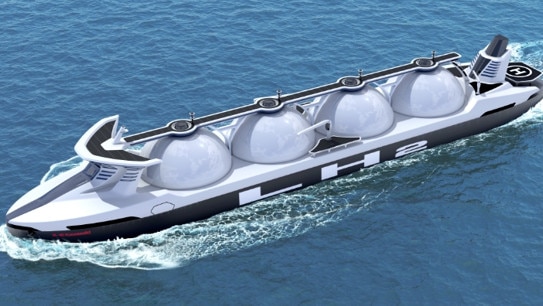Rio Tinto chief scientist Nigel Steward says hydrogen ‘hype’ faces tough tests in reality
Rio Tinto chief scientist Nigel Steward told investors that shipping liquid hydrogen could accelerate global warming, rather than help.

Rio Tinto’s chief scientist has fired a shot across the bows of companies and governments banking on green hydrogen “hype” as a solution to global warming, saying the company does not see hydrogen as a serious alternative to fossil fuels as an export commodity.
Speaking at Rio’s London investor day on Wednesday, Rio chief scientist Nigel Steward said the company did not believe hydrogen could be used as an “energy carrier” in the near future, given its production costs and problems with shipping it around the globe.
“Hydrogen is much hyped, particularly as an energy carrier. We don’t see hydrogen as being used as an energy carrier,” he said.
Mr Steward’s comments fly in the face of the ambitions of Andrew Forrest’s Fortescue Metals Group, which plans to spend billions in the hope of turning green hydrogen into a major seaborne commodity.
But the Rio chief scientist warned investors that recent research suggested that direct shipping of hydrogen at scale could even exacerbate global warming.
“If we want to use hydrogen as an energy carrier, and we‘re going to transport it around the world as liquid hydrogen, that’s problematic because 1 per cent of the hydrogen per day is lost to the atmosphere,” he said.
“Recent studies have shown that hydrogen actually has a global warming potential five to 16 times greater than carbon dioxide. So what this means is it is better to burn natural gas than it is to transport hydrogen around the world and then consume that later.”
Fortescue and other hydrogen hopefuls have said they plan to tackle the issue of energy loss in transporting liquid hydrogen by instead producing ammonia as a means to transport the commodity. But that would require additional chemical processes that would use even more energy, making its use less efficient.
Mr Steward said Rio believed hydrogen could have a major role to play in global energy transition, but said the mining giant believed it was best consumed where it was produced.
“We see hydrogen being used for its unique chemical properties. As a reducing agent for production of green steel, as a reducing agent for ilmenite in the smelting process to make iron and titanium, and also as a source of energy for calcining alumina in our refineries,” he said.
But even that would require a significant technological breakthrough to bring production costs down, he said, given hydrogen production requires significantly more energy to produce than even aluminium smelting.
“It’s a very, very energy intensive material. It requires four times the amount of energy per tonne to produce than aluminium – and we think of aluminium as being very energy intensive,” he said.





